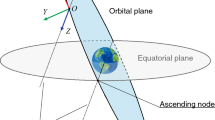Abstract
Direct solar radiation pressure and Earth’s shadow crossings are known to be responsible for short-term variations of space debris orbital elements, the higher the area-to-mass ratio the larger the perturbation. Nevertheless, existing studies have always been performed on periods of time shorter than 150 years. Considering longer time scales of the order of a 1000 years, this paper focuses on the long-term periodic evolution of space debris trajectories caused by successive Earth’s shadow crossings. Other perturbations as the geopotential and third-body gravitational attractions obviously play a role and compete with the one which is described in this paper. Symplectic numerical propagations and new (semi-)analytical models are developed to identify a frequency associated to shadow entry and exit eccentric anomalies. It is shown that Earth’s shadow is responsible for large deviations from the initial orbital elements, even on shorter period of times, and that this effect increases along with the area-to-mass ratio.









Similar content being viewed by others
References
Aksnes, K.: Short-period and long-period perturbations of a spherical satellite due to direct solar radiation. Celest. Mech. 13, 89–104 (1976)
Anselmo, L., Pardini C.: Orbital evolution of geosynchronous objects with high area-to-mass ratios. In: Proceedings of the Fourth European Conference on Space Debris, ESA SP-587, ESA Publications Division, Noordwijk, The Netherlands, pp. 279–284 (2005)
Chao, C.C.: Analytical investigation of GEO debris with high area-to-mass ratio. AIAA paper no. AIAA-2006-6514. Presented at the 2006 AIAA/AAS astrodynamics specialist conference, Keystone, Colorado (2006)
Delsate, N., Compère, A.: NIMASTEP: a software to modelize, study and analyze the dynamics of various small objects orbiting specific bodies. Astrono. Astrophys. 540, A120 (2012)
Escobal, P.R.: Methods of Orbit Determination, 2nd edn. Krieger Publishing, Florida (1976)
Ferraz-Mello, S.: Analytical study of the Earth’s shadowing effects on satellite orbits. Celest. Mech. 5, 80–101 (1972)
Hairer, E., Norsett, S.P., Wanner, G.: Solving Ordinary Differential Equations I: Nonstiff Problems, 2nd edn. Springer, New-York (1993)
Hubaux, Ch., Lemaître, A., Delsate, N., Carletti, T.: Symplectic integration of space debris motion considering several Earth’s shadowing models. Adv. Space Res. 49, 1472–1486 (2012)
Kozai, Y.: Effects of solar radiation pressure on the motion of an artificial satellite. Smithson. Astrophys. Obs. Spec. Rep. 56, 25–33 (1961)
Kuznetsov, E.D.: The effect of the radiation pressure on the orbital evolution of geosynchronous objects. Sol. Syst. Res. 45, 433–466 (2011)
Kuznetsov, E.D., Zakharova, P.E., Glamazda, D.V., Shagabutdinov, A.I., Kudryavtsev, S.O.: Light pressure effect on the orbital evolution of objects moving in the neighborhood of low-order resonances. Sol. Syst. Res. 46, 442–449 (2012)
Laskar, J., Robutel, P.: High order symplectic integrators for perturbed Hamiltonian systems. Celest. Mech. Dyn. Astron. 80, 39–62 (2001)
Lemaître, A., Delsate, N., Valk, S.: A web of secondary resonances for large \(A/m\) geostationary debris. Celest. Mech. Dyn. Astron. 104, 383–402 (2009)
Liou, J.-C., Weaver, J.K.: Orbital dynamics of high area-to-mass ratio debris and their distribution in the geosynchronous region. In: Proceedings of the Fourth European Conference on Space Debris, ESA SP-589, pp. 285–290 (2005)
McMahon, J., Scheeres, D.: Secular orbit variation due to solar radiation effects: a detailed model for BYORP, Celest. Mech. Dyn. Astron., 106, 261–300 (2010a)
McMahon, J.W., Scheeres, D.J.: New solar radiation pressure force model for navigation. J. Guid. Control Dyn. 33, 1418–1428 (2010b)
Meeus, J.: Astronomical formulae for calculators, 4th edn. enlarged and revised. Willmann-Bell Inc., Richmond (1988)
Mikisha, A.M., Smirnov, M.A.: The influence of solar light pressure to GEO objects. Evolution aspects. In: Proceedings of the Second European Conference on Space Debris, ESA SP-393, pp. 323–325 (1997)
Montenbruck, O., Gill E.: Satellite Orbits: Models, Methods, Applications, 3rd edn. corrected Springer, Berlin (2005)
Milani, A., Gronchi, G.: Theory of Orbit Determination, 1st edn. Cambridge University Press, Cambridge (2009)
Rosengren, A., Scheeres, D.J.: Averaged dynamics of HAMR objects: effects of attitude and earth oblateness. Paper no. AAS 11–594 presented at the 2011 AAS/AIAA sstrodynamics specialist meeting, Girdwood, Alaska (2011)
Rosengren, A.J., Scheeres, D.J.: Long-term dynamics of HAMR objects in HEO. Paper presented at the AIAA/AAS astrodynamics specialist meeting, Minneapolis, August 2012
Scheeres, D.J.: Orbit mechanics about asteroids and comets. J. Guid. Control Dyn. 35, 987–997 (2012)
Schildknecht, T., Früh, C., Herzog, A., Hinze, J., Vananti, A.: AIUB efforts to survey, track, and characterize small-size objects at high altitudes. In: Proceedings of 2010 AMOS Technical Conference, Maui, Hawaii, USA, 14–17 Sept 2010
Smirnov, M.A., Mikisha, A.M., Novikova, E.S., Rykhova, L.V.: Secular variations of semimajor axis of debris particles near GEO due to solar radiation pressure. In: Proceedings of the Third European Conference on Space Debris, ESA SP-473, pp. 403–406 (2001)
Valk, S., Lemaître, A., Anselmo, L.: Analytical and semi-analytical investigations of geosynchronous space debris with high area-to-mass ratios. Adv. Space Res. 41, 1077–1090 (2008)
Valk, S., Lemaître, A.: Semi-analytical investigations of high area-to-mass ratio geosynchronous space debris including Earth’s shadowing effects. Adv. Space Res. 42, 1429–1443 (2008)
Acknowledgments
The work of Ch. Hubaux is supported by an FNRS Ph.D. Fellowship. This research used resources of the Interuniversity Scientific Computing Facility located at the University of Namur, Belgium, which is supported by the F.R.S.-FNRS under convention No. 2.4617.07. This paper presents research results of the Belgian Network DYSCO (Dynamical Systems, Control, and Optimization), funded by the Interuniversity Attraction Poles Programme, initiated by the Belgian State, Science Policy Office. The scientific responsibility rests with its author(s).
Author information
Authors and Affiliations
Corresponding author
Rights and permissions
About this article
Cite this article
Hubaux, C., Lemaître, A. The impact of Earth’s shadow on the long-term evolution of space debris. Celest Mech Dyn Astr 116, 79–95 (2013). https://doi.org/10.1007/s10569-013-9480-0
Received:
Revised:
Accepted:
Published:
Issue Date:
DOI: https://doi.org/10.1007/s10569-013-9480-0




